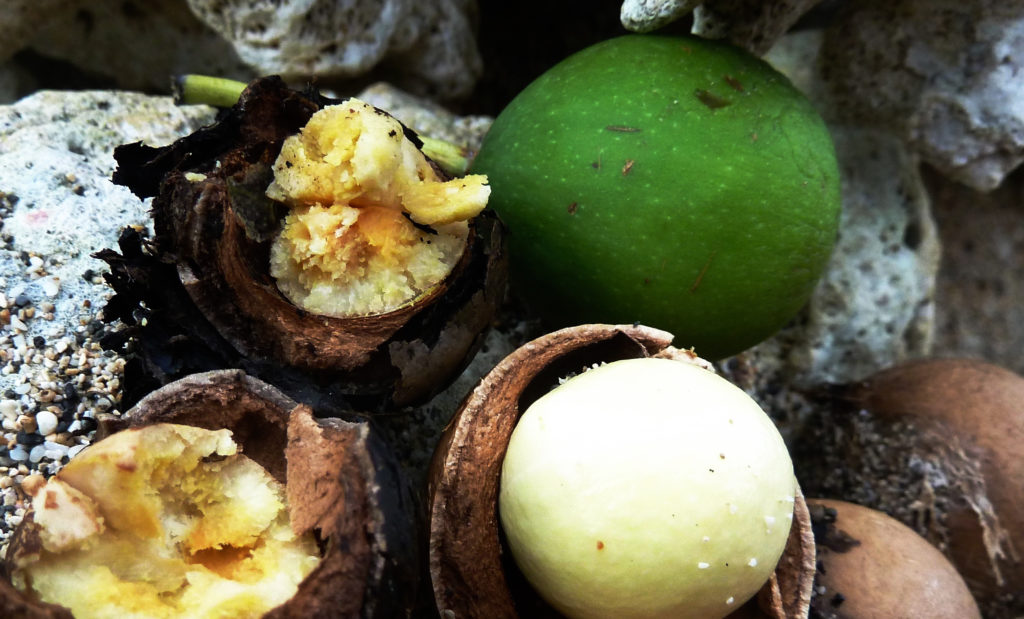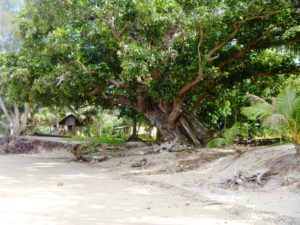TAMANU OIL SCIENTIFIC DATA ANALYSIS PROFILE

Tamanu Oil or Calophyllum Indophyllum Seed Oil goes by other names from Nabagura Oil, Dilo Oil, Floraha Oil, Domba Oil, Fetau or Fetaʻu Oil to Bitangor and Nyamplung Oil. Either way, Tamanu Oil research reveals a consistent range of scientific data and analysis that indicates that this skin rejuvenating oil may well be the No. 1 natural skin care product for problem skin and aging due to its unique ability to promote the growth of healthy, new skin cells.
Scientific Name – Calophyllum Inophyllum Nut Seed Oil
Origin – Vanuatu, South Pacific
Extraction – Cold Pressed/Unrefined/Virgin
Shelf Life – 24 months (minimum)
Product Classification – Wild Harvested
INCI Name – Calophyllum Indophyllum Seed Oil
CAS Number – 223748-12-7
Color – Dark Greenish Odor – Nutty, fatty and odoriferous
Storage:
Best stored at room temperature. Do not refrigerate. Tamanu Oil doesn’t mind warm temperatures but extreme heat will lessen the shelf life. Cool to cold temperatures will cause some separation of the fatty acids but this otherwise will not affect the shelf life of pure Tamanu Oil. For external use only. As with all skin care products, test for any allergic reaction on a small area of the skin first.
Note: Avoid Tamanu Oil that is virtually black. This generally means that the oil is old stock that has oxidized over time or the Tamanu Nuts have not been cured correctly (for example, burnt in the fire to try and speed up the curing process). Avoid using Tamanu Oil that has been diluted down with carrier oils like Olive Oil as this may affect the efficacy (effectiveness) of the product.
USES FOR TAMANU OIL:
Can be used as a stand-alone cosmetic product or as a natural ingredient for cosmetic formulations and hair products.
SECONDARY USES:
What is not commonly known is that Tamanu Oil is fantastic for animal skin conditions as well – just check out these before and after photos of a horse called Satin Doll using a specially modified version of our Tamanu Butter for horses. However, it is not recommended for animals such as cats as they spend a lot of time preening themselves. This can result in them indirectly ingesting Tamanu Oil which can make them sick. Tamanu Oil is a topical agent only.
Below you will find the main components of pure Tamanu Oil.
MAIN ACTIVE INGREDIENTS: Calophyllolide Lactone OTHER ACTIVE INGREDIENTS: Friedelin, SCIENTIFIC SPECIFICATIONS Ph: 4.0 to 7.0 | ASSAY TEST RESULTS Oleic- 37.15% |
THE BOTANICAL USES OF TAMANU OIL
Tamanu oil is a wonderful, fast-acting skin rejuvenating agent. In fact, it is not just the oil extracted from the Tamanu Nuts that has been used for centuries by the Melanesian people of Vanuatu but the bark and leaves of the Tamanu Tree as well.
When it comes to natural skin care products or organic skin care products, our wild harvested Vanuatu Tamanu Oil is hard to beat because it is naturally organic and not the product of some artificial certification process. Further, it is probably the No. 1 natural skin care product on the market today and we are not just referring to essential oils or bulk ingredients – we mean the best organic skin care product and aromatherapy oil fullstop!
The Tamanu Tree is indigenous to the tropical islands of Vanuatu (formerly the New Hebrides). It also grows in countries such as Guam, Hawaii, Thailand, Malaysia and even Vietnam. However, care needs to be taken here as the quality of the oil can often leave much to be desired. It is very much “you get what you pay for”. The tree itself flowers bi-annually with fragrant, white blooms that produce clusters of round fruit that look like large nuts. Inside each of these fruits is an actual nut kernel and it is from these kernels that Tamanu Oil is extracted.

However, this nut kernel must be allowed to cure over a 6-8 week period until it becomes sticky with a dark, thick, rich oil which is then cold-pressed out of the nut kernel (see the Tamanu Oil Flow Chart above).
The real healing power of this traditional topical oil is its unique ability to stimulate the growth of healthy new skin tissue. This process is referred to scientifically as “cicatrisation” and scientific studies clearly establish that Tamanu Oil is a significant healing agent.
This natural skin care product is the perfect product and one that everybody should have in their bathroom cabinet. Yes, it is expensive but not when you consider that it takes 4 mature trees to produce enough nuts to yield just 20 liters of oil.
WARNING: Avoid buying Tamanu Oil from anyone or any company that claims that any signs of deposits, deep dark green color and strong smell are signs of the active ingredients deteriorating making its effectiveness less beneficial for your skin. This is completely and utterly untrue. In fact, it is quite the opposite. Pure Tamanu Oil should be dark green in color and have a strong aroma. These are its natural attributes and very much a part of the essential goodness and effectiveness of high grade Tamanu Oil.
What is the best oil you ask? Vanuatu Tamanu Oil™ as recommended on The Dr Oz Show is the simple answer.
TAMANU OIL SCIENTIFIC STUDIES
Sc Glucan in Tamanu Oil provides natural UV protection. Sc Glucan protects against UV-induced DNA damage and oxidative stress as a new biological UV filter with a SPF 18-22 in ophthalmic preparations. This natural UV filter, inhibit 85 % of the DNA damage and oxidative stress induced by UV radiation at 1% concentration in opthalmic preparations (Eur J Pharm. Sci 2007 Mar; 30(3-4):203-10. Epub 2006 Nov 9). Calophyllum Inophyllum Oil, even at low concentration (1/10,000, v/v), exhibited significant UV absorption properties (maximum at 300nm) and was associated with an important sun protection factor (18-22) in opthalmic preparations (Eur J Pharm. Sci 2007 Mar; 30(3-4):203-10. Epub 2006 Nov 9).
Below are examples of more studies on just some of Tamanu Oil benefits:
1.Soothing and protective effect on the skin (sunburn, inflammation, skin redness, insect bites) EVIC-CEBA laboratory study 06/2000 – Ih268/01.
- Regenerating effect on the epidermis cells, wound healing (burns, cuts, cracks, scars…) Microna laboratory feb. 2003 – N°03/0607i
3.Improves the appearance of aged scars (1 year or older) Australian Society of Cosmetic Chemists Annual Congress, Hamilton Island 2003
The role of natural ingredients in anti-aging of the skin
4. Anti acne, anti septic (Phytochemistry. 2004 Oct;65(20):2789-95),
5.Anti-inflammatory (ABICH oct.2005 – REL/244/05/FUNZ/ELB),6.anti-viral (Bioorg Med Chem Lett. 1998 Dec 15;8(24):3475-8) & (Med Res Rev. 2000 Sep;20(5):323-49),7.antibiotic, anti-coagulative, fungal inhibitor (Yao Xue Xue Bao. 2004 Apr;39(4):305-8) and antibacterial effects (Microna laboratory oct.2002 – °02/4500i) & (Indian J Exp Biol. 1970 Jan;8(1):39-40).
- Cancer chemopreventive agents (anti-tumor-promoting agents). Cancer Lett. 2001 Aug 10;169(1):15-9
9.Moisturising, nourishing and repairing (epidermal cells) effect on the skin (dry and damaged skin, wrinkles, anti-aging…) Microna laboratory feb.2003 – N°03/0607i
10.Increases microcirculation (heavy legs, bruising…) Dermscan – april 2007 – study N°07D0458
11.Body hygiene (body odors, infections, skin rashes, dermatitis, psoriasis…) Phytochemistry. 2004 Oct; 65(20):2789-95
12.Hypoallergenic (nonirritant, non-sensitizing). Dermscan April 2007- study DN-730/07EO398
13.A naturally occurring anti HIV agent (Pharm. Biol., vol 37, n 1, pp71-76)
- Regenerating effect on the epidermis cells, wound healing (burns, cuts, cracks, scars…) Microna laboratory feb. 2003 – N°03/0607i
Importantly, our Vanuatu Tamanu Oil is exempt of the 26 allergen substances listed in 2003/15/CE European directive.
